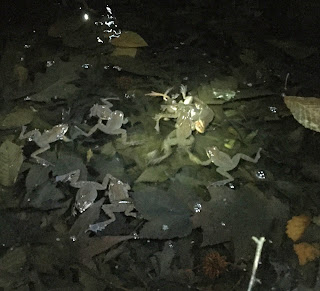Vernal pools are the place to be right now, if you're a wood frog, spring peeper, or a spotted salamander. Vernal refers to springtime, and vernal pools are generally small bodies of water that form in winter in depressions in the forest. Some quickly fade as spring progresses, but a few good ones remain long enough in the spring to allow amphibians to complete their reproductive cycle. The underlying hydrology and precipitation need to be sufficient to sustain water until the tadpoles mature. A lake or pond with water yearround might seem a safer bet, but would contain fish interested in eating the amphibians' eggs.
On warm, wet nights, the frogs and salamanders migrate from surrounding forest to the vernal pools to breed. Leaves from the previous fall provide cover, as in this photo of a spotted salamander. Thanks to Lisa Boulanger, who lives up near Herrontown Woods, for sharing these first couple photos. Last year she
raised some salamanders from eggs laid in her backyard swimming pool.
Oftentimes, and sometimes tragically, roads stand between the amphibians and their vernal pools. The Sourlands Conservancy has a well-organized program in which trained volunteers with flashlights and reflective clothing monitor roadways on wet, warm nights in late winter, posting warning signs along stretches of roadway and helping the amphibians cross the road. They make sure their hands are free of lotions that might affect the amphibians' skins.
Though we made preliminary inquiries about doing a similar initiative in Princeton this year, it didn't go beyond our checking one stretch. Surprisingly, the two live frogs I saw on the pavement were sitting there, oblivious to danger. Perhaps they are soaking up some heat from the pavement, or are confused by the curious surface. I was able to hasten their crossing just by approaching them.
By the time I had gotten there, however, soon after nightfall on March 6, many had already been run over, despite the minimal traffic along Herrontown Road. Returning a few days later, I found the remains of fifty. This is yet another example of how people can do harm without the least intention of doing so.
Here are a couple wood frogs in what's called "amplexus," with the smaller male holding onto the pinkish female. It looks all very ordered and peaceful, but when we visited a vernal pool in Herrontown Woods a week ago, the competition between males for females was intense, to the point of imperiling the females.
In this photo, by Mark Manning, the tussle looks pretty benign.
Elsewhere in the pool, a female looked to be in trouble, with about ten males trying, persistently despite their lack of success, to dislodge the other male from the female's back. The female's head, a lighter brown, can be seen in the photo. In this mob scene, the female will literally not be able to come up for air.
Insects are active in the vernal pools as well. One of Mark's sons brought me this predatory water stick-insect.
Interestingly, while the salamanders and frogs hadn't even laid eggs yet, there were already large tadpoles swimming in the water. These, according to Mark, are green frogs that have a different timing than the wood frogs.
It was Mark's birthday, which says something about his passion. Deep in woods, peering into the still waters so rich in life, we all felt like we were in the presence of a great gift.
Thanks to Mark, Fairfax and Lisa for their photos, their knowledge, and their initiative.









No comments:
Post a Comment